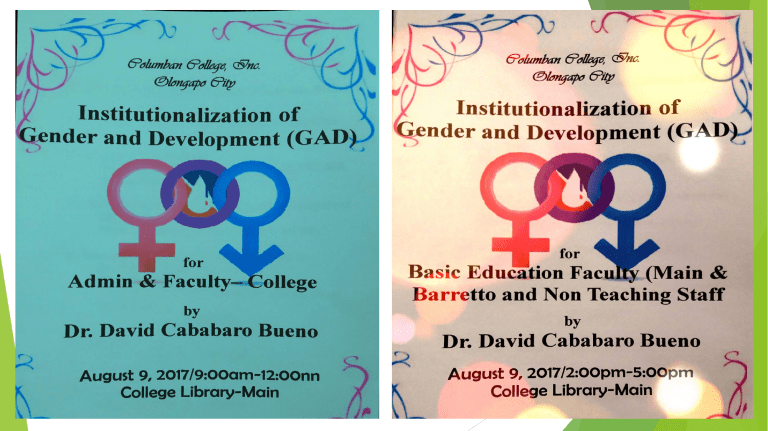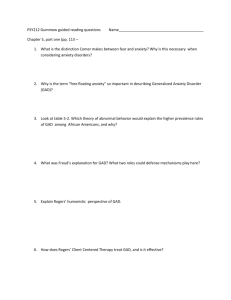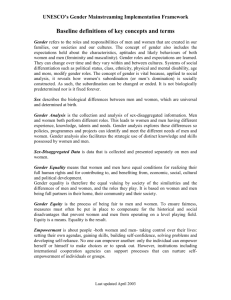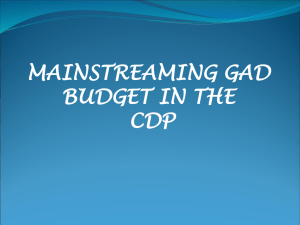Dr. David Cababaro Bueno - INSTITUTIONALIZATION OF GAD AT CCI
advertisement

The full and complete development of a country, the welfare of the world and the cause of peace require the maximum participation of women on equal terms with men in all fields. The full and complete development of a country, the welfare of the world and the cause of peace require the maximum participation of women on equal terms with men in all fields. Facts… The Convention on the Elimination of All Forms of Discrimination against Women (CEDAW), often described as the international bill of rights for women, was ratified by 177 countries including the Philippines. The Philippines signed the Millennium Declaration, which includes the promotion of gender equality as its third goal. Facts… The target of eliminating gender disparity in primary and secondary education, preferably by 2005, and all levels of education not later than 2015, is projected to be reached or even surpassed by the Philippines. equality is integral to the achievement of the Millennium Development Goals (MDGs). Gender Facts… Without progress toward gender equality and women’s empowerment, none of the MDGs and their targets will be achieved. It is also one of few countries with gender equality provisions in its Constitution. Section 14 of Article II states that “it recognizes the role of women in nation-building, and shall ensure the fundamental equality before the law of women and men.” Facts… Other noteworthy laws and policies promoting gender equality are the Women in Development and Nation-Building Act (Republic Act [RA] 7192), The Philippine Plan for Gender-Responsive Development (PPGD), The Anti-Sexual Harassment Act (RA 7877), Facts… The Anti-Trafficking in Persons Act (RA 9208), The Anti-Violence against Women and Their Children Act (RA 9262), Laws on Rape (RA 8353 and RA 8505). Facts… It has been proven that any effort toward sustainable development requires the participation of women at all levels of policymaking and policy implementation. Facts… The Philippines has been taking concrete steps toward integrating GAD concerns in the development process. The Harmonized Gender and Development Guidelines is a vital contribution to this process of gender mainstreaming---processes and mechanisms for the Philippine Plan for GenderResponsive Development as part of our efforts to implement RA 7192, Facts… The international development partners in the Philippines, are happy to collaborate with the National Economic and Development Authority (NEDA) and the Philippine Commission on Women (PCW) in producing guidelines. Facts… Asian Development Bank (ADB) Australian Agency for International Development (AusAID) Canadian International Development Agency (CIDA), European Commission (EC) International Labor Organization (ILO) Japan International Cooperation Agency (JICA) United Nations Children’s Fund (UNICEF) United Nations Development Program (UNDP), United Nations Population Fund (UNFPA) United States Agency for International Development (USAID) the World Bank (WB) World Health Organization (WHO) Voluntary Service Overseas Philippines (VSOP) CHED Memorandum Order No. 01, S. 2015 “ESTABLISHING THE POLICIES AND GUIDELINES ON GENDER AND DEVELOPMENT IN THE COMMISSION ON HIGHER EDUCATION AND HIGHER EDUCATION INSTITUTIONS (HEIs)” CHED Memorandum Order No. 01, S. 2015 for the institutionalization of gender equality and GAD in the policies, operations and programs of HEIs. GAD initiatives and effort of the CHED… categorized into three Policy, Programs and People. areas: Policies The Commission on Higher Education has issued Special Orders and Memoranda relative to the following: Policies Prescribing Guidelines and Procedures for the Implementation of the Magna Carta of Women… Creating and/or strengthening the GAD Focal Points in CHED Central Office and Regional Offices---HEIs… Policies Reviewing GAD plans to ensure compliance with the provisions of the IRR pertaining to the role and responsibilities of CHED and HEIs… Policies Spearheading an Information and Education Campaign to advocate for full implementation of RA 9710 and its IRR, to Student and Faculty Orientation programs each semester, and directed that this be made part of schools’ annual compliance requirements… Policies The Gender and Development Accord of Philippine Higher Education Institutions (HEIs), the harbinger of the future CMO on mainstreaming gender equality in higher education as a policy… Policies CHED Memorandum Order No. 1, series of 2015, which seeks to promote gender-sensitive/responsive and rightsbased policies, curricula, instructional materials, as well as research and extension services in all higher education institutions… Policies Institutionalizing in the CHED system of a Technical Panel on Gender and Development--HEIs… Programs In order to achieve the goals set by the Commission in terms of promoting gender equality, women empowerment, and elimination of gender disparity in higher education, we have institutionalized the following programs: Programs Programs to increase and maintain the enrolment of females in traditionally male-dominated courses and conversely, males in traditionally female-dominated course offerings through the grant of scholarships; Programs Programs for intervention to assist female students with extreme personal circumstances that hamper their completing courses until graduation; Programs Faculty Development programs to enhance professional skills of teachers including those specializing in gender-related courses; Programs Institutionalization of the Committee on Decorum and Investigation (CODI) to eliminate all forms of gender-based sexual harassment in the educational workplace or training areas; Programs Review by colleges of their operational policies as well as research and extension programs making these more gender-responsive. Programs Extension services address the gender issues of poverty through training for livelihood (organic farming, revival of heritage products, food processing etc.), health services, and psychosocial services for women and indigenous peoples, as well as advocacy programs for social protection of women. Programs Publication of the Higher Education Gender Handbook. A compendium of data and information on GAD-related concerns, to ensure that the HEIs under its jurisdiction are guided accordingly in fast tracking gender mainstreaming, institutionalizing GAD-related policies, and implementing related programs and projects. Programs The Higher Education Summits on Gender Issues has become a major program. People In order to develop people and the GAD human resource, capacity building for GAD focal persons of CHED central and regional offices and HEIs were conducted nationwide. People Gender Consciousness including Orientation on the Magna Carta for Women and GAD Focal Point System Guidelines, Gender Sensitivity, Women, Peace, and Security; People GAD Skills including training on Gender Analysis, GAD Planning and Budgeting, Use of the Harmonized Gender And Development Guidelines, Capacity Development in Fulfilling the Provisions of the Magna Carta of Women, Assessing Programs and Projects, Effective Management, Elimination of Genderbased Violence on Campuses. Challenges and Opportunities for Promoting Gender Equality in HEIs … The challenges and opportunities that ASEAN integration poses to the promotion or advancement of gender equality in HEIs; The gender/women’s studies programs that have been adapted to the specific contexts of ASEAN member countries and may serve as templates; The approaches and strategies of member countries in preparing Higher Education for full ASEAN integration. Emerging social issues and concerns that affect women and families food security, vulnerability to climate change, need for disaster preparedness and prevention, and search for equitable and sustainable growth. The mainstreaming of GAD in higher education is therefore essential to the success of ASEAN integration. GAD should be part of the higher education system of all member countries. Philippine Plan for Gender-Responsive Development (PPGD) Vision Gender equality Women’s empowerment Sustainable development Peace and social justice Actualization of human potentials beyond basic needs Democratic participation Self-determination at all levels Respect for human rights Philippine Plan for Gender-Responsive Development (PPGD) Goals 1. Increased economic empowerment of women 2. Protection and fulfillment of women’s human rights 3. Gender-responsive governance Philippine Plan for Gender-Responsive Development (PPGD) Strategies (G1) Enhancement of sustainable access of women to capital, market, information, technology, and technical assistance Enhancement of employment and livelihood skills of women, particularly in high-value-adding industries and agricultural activities Establishment of an enabling environment that will ensure the effective implementation of policies for the protection of woman workers Increase in women’s awareness of their economic rights and opportunities Strengthening of women’s representation in economic decisionmaking bodies Philippine Plan for Gender-Responsive Development (PPGD) Strategies (G2) Enhancement of women’s access to/utilization of basic social services Promotion of a gender-responsive delivery of justice to violence against women (VAW) survivors Formulation and implementation of legislative measures that will eliminate gender bias Promotion and advancement of women and girlchildren’s human rights Philippine Plan for Gender-Responsive Development (PPGD) Strategies (G3) GAD mainstreaming in the bureaucracy Enhancement of women’s leadership roles and participation in decision making Strengthening of women’s role in promoting genderresponsive governance Strengthening of government partnership with media in covering various women’s issues Gender equality and women’s empowerment outputs and outcomes… Improved physical welfare of women and girls; lower incidence of malnutrition, morbidity, and mortality among girls and boys; lower maternal morbidity and mortality; improved functional literacy of various groups of women, particularly among the older age groups in rural areas and among indigenous peoples groups; and improved school participation of girls and boys at various levels; Gender equality and women’s empowerment outputs and outcomes… Equal access of women and men to development opportunities (including employment generated by the project), resources, and benefits, which implies the removal of constraints, barriers, and various forms of gender-based discrimination with respect to women’s access; Gender equality and women’s empowerment outputs and outcomes… Greater understanding of women’s human rights among women and men; commitment of the State to recognizing, protecting, and fulfilling human rights, particularly of women and girls; or changes in attitudes and beliefs concerning gender relations, as indicated by a reduction in the incidence of violence against women and a more equal gender division of labor; Gender equality and women’s empowerment outputs and outcomes… Equal participation of women in bodies or organizations created by development programs or projects; and higher representation of women in various decision-making bodies and leadership positions; and Equal control of women and men over resources and processes and outcomes of development. GAD Monitoring Indicators AGRICULTURAL AND RURAL DEVELOPMENT INFRASTRUCTURE PRIVATE SECTOR DEVELOPMENT SOCIAL SECTOR: EDUCATION SOCIAL SECTOR: HEALTH SOCIAL SECTOR: HOUSING AND SETTLEMENT SOCIAL SECTOR: PROJECTS FOR AREAS UNDER ARMED CONFLICT, OR WOMEN AND PEACE PROJECTS The Institutionalization Process A. The GAD Focal Point System (GFPS) 1. Composition School President as Head The President’s Advisory Council---Management Committee (Members of the Management / Executive Committees) GAD Focal Committee---Chaired by Dean or Department Chair with designated staff members Secretariat composed of identified support staff for various colleges/ departments The Institutionalization Process A. The GAD Focal Point System (GFPS) 2. Duration of Designation to the GFPS For a period of at least three (3) years 3. Duties and Functions 4. Review of Policies, Standards and Guidelines 5. Funding Requirements of the GFPS (allocate reasonable portion of the annual budget) The Institutionalization Process B. Curriculum Development 1. Statement of Policy Revision of gender stereo types and images in instructional materials and curricula GAD sensitive language shall be used at all times Capacity building on GAD, Peace and human rights, education for teachers and those who are involved in the education sector 2. Obligations---respect the rights off women, refrain from discriminating against women and violating their rights, protect women against discrimination and from violation of their rights by private corporations, entities or individuals, and promote the rights of women in all spheres. The Institutionalization Process B. Curriculum Development 3. Gender Mainstreaming strategies --- reflected in the institutional development plan, the training in gender analysis on sexism and other forms of gender biases in curriculum design, learning materials, pedagogical practices and disciplinary policies; training on gender related topics into various courses/ disciplines; and training in the development of genderresponsive performance monitoring guidelines and tools. 4. Library and Learning materials---provision of adequate and accessible library learning materials across disciplines 5. Related Activities---participation to GAD related conferences, fora, conventions and meetings. The Institutionalization Process B. Curriculum Development 5. Creation of a Technical Panel on Gender and Women Studies (TPGWS) to review course offerings, research proposals, and extension projects; review gender sensitive curriculum materials and instructional plans; and assistance in mainstreaming of gendersensitive principles into curricular proposals 6. Discipline Specific Manuals and Guidelines 7. Budgetary and Planning Requirements The Institutionalization Process C. Gender Responsive Research Program (GRRP) 1. Statement of Policy- support policies, researches, technology, and training programs and other support services such as financing, production and marketing to encouraged active participation of women 2. Complementation with the NHERA—develop research capacity and enhance research productivity, identify research priority areas and programs, conduct of gender responsive researches The Institutionalization Process C. Gender Responsive Research Program 3. Gender-Responsive Research Programs (GRRP) --- integrate in the Institutional Plan the priority research areas, established GAD data-based with sex-disaggregated data and statistics, GAD policy and program assessment and evaluation, establishment of an Ethics Board, incentives and other support structures The Institutionalization Process C. Gender Responsive Research Program 4. Priority Areas ---gender studies/ research in all disciplines, specific topics for gender and social issues, gender in power and decision making, economic empowerment- (livelihood skills, process of running a business such as accounting, bookkeeping, production, product branding, marketing), indigenous women and girls and other marginalized sectors in education, career tracking of women, women in history, and other gender issues 5. Budgetary and Planning Requirements – allot an appropriate outlay to support gender studies and researches The Institutionalization Process D. Gender Responsive Extension Program (GREP) 1. Statement of Policy- communicate, persuade and help specific sectors to improve production, the institution/ organization and quality of life. 2. Principles--- social protection- policies and programs to reduce poverty and vulnerability to risks, enhance social status, protect and promote livelihood and employment, protect against hazards and sudden loss of income, improve capacity to manage risks, social insurance, social welfare and social safety nets; and appropriate technology- skills and materials readily available. The Institutionalization Process D. Gender Responsive Extension Program (GREP) 3. Priority Areas ---technology transfer, livelihood programs with financial literacy, technical assistance, advocacy, and linkages. 5. Budgetary and Planning Requirements – allot an appropriate outlay to support gender responsive extension projects and programs The Institutionalization Process E. GAD Student Financial Assistance Program 1. Qualified women belonging to marginalized group--living in poverty with little or no access to land and other resources, basic and social services such as health care, education, water and sanitation, employment and livelihood opportunities, housing, physical infrastructure, and justice system. The Institutionalization Process E. GAD Student Financial Assistance Program 2. Qualified women living in “especially difficult circumstances”- victims and survivors of sexual and physical abuse, illegal recruitment, prostitution, trafficking, armed conflict, women in detention, victims and survivors of rape, incest and other related circumstances… 3. Qualified women affected by disasters, calamities and other crisis situations. The Institutionalization Process F. GAD Planning and Budgeting 1. The GAD mandates and other issues that the school intends to address 2. Corresponding programs and activities to address the issues 3. Necessary budget to implement these activities and programs Note: Gender issues and corresponding projects, programs and activities maybe either client-focused or organization-focused The Institutionalization Process G. Sex-disaggregated Data and GAD Database 1. Guidelines and MIS to include collection of sexdisaggregated data. 2. Analysis of sex-disaggregated data Thank YOU and Mabuhay ang GAD!!!




